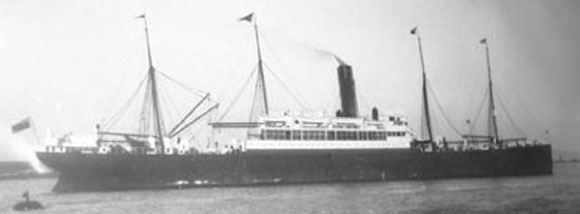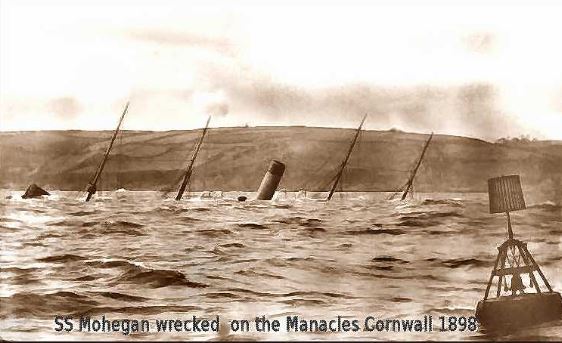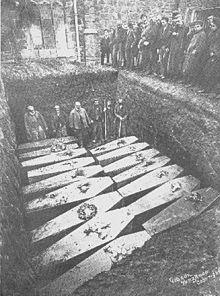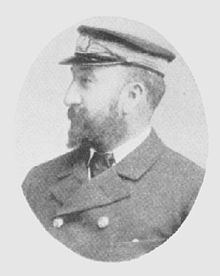Mohegan 1898
N50 02.720 W5 02.588


The SS Mohegan started life as the Cleopatra, a mixed passenger liner and animal carrier. She was built alongside four others at Earle’s Shipbuilding and Engine Company, Hull, for the Wilson & Furness-Leyland Line. She was rated A1 at Lloyd’s of London. She was built for ‘safety at sea’ and was equipped with eight watertight bulkheads, failsafe lighting and pumping systems, eight lifeboats capable of carrying 59 passengers each and three compasses. She could carry 120 first class passengers, with stalls for 700 cattle.
She did not serve with the Wilson & Furness-Leyland Line, instead being purchased by the Atlantic Transport Line, who were seeking to replace ships that had been requisitioned as troop transports by the United States government for use in the Spanish–American War. The other four ships acquired in this period were the Alexandria, Boadicea, Victoria and Winifreda, at a cost of around £140,000 per ship.
Bound for New York, Mohegan sailed from Tilbury Docks at 2:30pm on 13 October 1898, under the command of the 42-year-old Captain Richard Griffith. She carried 57 passengers, 97 crew, seven cattlemen, and 1,286 tons of spirits, beer, and antimony. She arrived off Dover at 7:30 that evening, dropping her pilot. A report on the progress so far from the Assistant Engineer was probably landed at this time. A few minor leaks and electrical failures were reported but otherwise no major problems had been encountered.
Mohegan then reached her maximum speed as she sailed down the English Channel. She kept close to the coast as she passed Cornwall, but took the wrong bearing. This was noticed by some of the officers and crew. They had noticed that the Eddystone Lighthouse was too far away and the coast too close. She neared the entrance of Falmouth Harbour and turned towards the entrance of the Helford River and on down The Lizard coast without slowing from 13 knots. This was noticed by the Coverack coastguard, which attempted to signal to her with warning rockets. The Mohegan either was unaware or took no notice, and maintained her course. James Hill, coxwain of the Porthoustock lifeboat saw the ship, lights ablaze, heading at full speed towards the Manacle Rocks. With a cry of ‘She’s coming right in!’ he called his crew.
The crew were finally alerted now to the danger, whether by the signals from shore or by the ‘old Manacle bell’ from the buoy, and the engines were stopped at 6:50 PM, but too late. The Mohegan ran onto the Manacles, embedding the rudder into the rock and tearing the hull open. The ship had struck Vase Rock, and now drifted onto the Maen Varses reef. Dinner was being served at the time, and many of the passengers were initially unaware of the severity of the accident. The engine room was almost immediately flooded to three feet. The steam gauges broke and the crew rushed to the deck. The ship was plunged into darkness soon after. With the loss of power the passengers made their way onto the deck, where attempts were made to launch the lifeboats.
 Captain Griffith had ordered the fitting of a high second rail inboard of the lifeboats to prevent their being rushed in the event of an emergency, but this now hampered the launching of the boats. Further problems were encountered when the ship listed to port then heavily to starboard. Only two lifeboats were launched, of which one was virtually swamped and the other capsized. The ship rolled and sank 12 minutes after hitting the rocks, with the loss of 106 lives. Captain Griffith, Assistant Engineer William Kinley and all of the officers went down with the ship. Only her funnel and four masts remained above water. The Porthoustock lifeboat Charlotte was launched in 30 minutes and rescued most of the survivors from the wreck and the water; 44 persons were saved.
Captain Griffith had ordered the fitting of a high second rail inboard of the lifeboats to prevent their being rushed in the event of an emergency, but this now hampered the launching of the boats. Further problems were encountered when the ship listed to port then heavily to starboard. Only two lifeboats were launched, of which one was virtually swamped and the other capsized. The ship rolled and sank 12 minutes after hitting the rocks, with the loss of 106 lives. Captain Griffith, Assistant Engineer William Kinley and all of the officers went down with the ship. Only her funnel and four masts remained above water. The Porthoustock lifeboat Charlotte was launched in 30 minutes and rescued most of the survivors from the wreck and the water; 44 persons were saved.
Most of the cargo was salvaged, though a diver lost his life in the process. The wreck gradually disintegrated in the following years. The third officer, William Logan Hindmarsh, age 30 is buried in the graveyard in Coverack, with an inscription indicating that the boat company paid for his gravestone and interment.
Today the wreck is well broken up with her boilers at around 22 going down to 26m
Nationality: British
Owner: Wilson & Fumess-Leyland Line
Builder: Earle’s Shipbuilding & Engine Co., Hull
Launched: April 1898 as “Cleopatra” Renamed Mohegan October 1898
Tonnage: 3670 tons
Length: 475 ft
Beam: 52 ft
Propultion: Single screw
- triple expansion engines with cylinders of 32 inches, 54 inches, and 90 inches, and a stroke of 66 inches
Four boilers operating at 200 psi
Speed: 13 kts
Capacity: 120 first class & 700 cattle class
